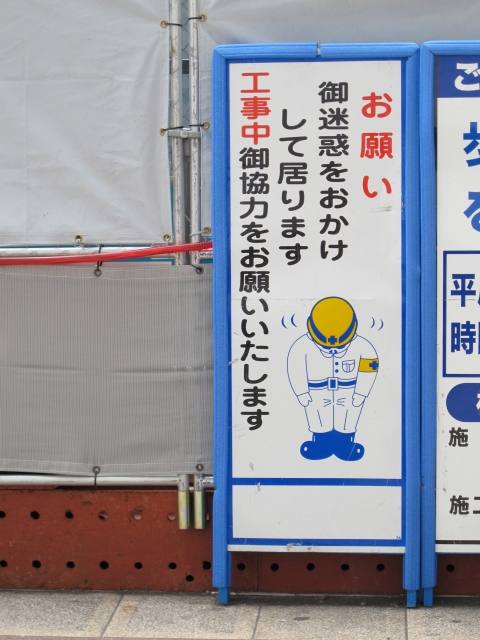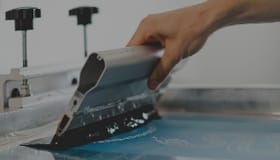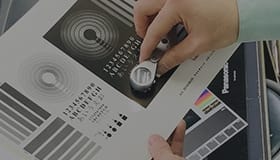Product overview
VS Ink has excellent printability on PVC products such as PVC stickers, PVC sheets, and wallpaper, especially on embossed surfaces. It has excellent blocking resistance, and by using this ink, various PVC sheets printed material can be produced with excellent finish.
- Solvent type ink

Application
- PVC products such as PVC sticker, PVC sheet, wallpaper, especially on embossed surface
Features, Function
- Fast drying and particularly excellent blocking resistance.
- Low odor ink that does not contain any heavy metals.
- A high solvent thinning rate can cut the cost of ink.
Substrate
- Soft & rigid PVC, Acrylic, ABS
- PMMA
- PVC
- ABS
Dilution
- E-001 SOLVENT(fast) E-002 SOLVENT(standard) E-003 SOLVENT(slow)
- E-004 SOLVENT(extra slow) Dilution: 30 to 50%
- *Do not use other solvents as they may adversely affect curing, adhesion, stencil stability, or other properties.
Promoter
- SM-40 DEFOAMER 2% (For anti-foam and improvement in leveling)
Recommended cleaner
- Screen Cleaner L2 or E-002 SOLVENT
Mesh
- T 150 to 300 mesh(Coverage is 28 to 34m2/kg at 250 mesh)
Drying
- 50-60℃ 10 min
- *Drying time may vary depending on the substrate.
- *Tack-free time is about 10 min at room temperature and about 5 min by blow dry with jet dryer.
- *It is necessary to select optimum drying temperature and time depending on the intended use of the printed materials.
Standard colors
-
000 MEDIUM
-
002 EXTENDER
-
061 WHITE
-
061 C OPAQUE WHITE
-
091 BLACK
-
092 BLACK(WELDER)
Caution
- Soft PVC sheet is likely to remain solvent in the sheet, which can cause problems in subsequent processes.
- Adhesion test must be done before printing as quality of plastic may differ depending on manufacturers or lots. It is also recommended to wipe surface of the printing part with alcohol or mineral spirits to prevent defective print due to static electricity and insufficient adhesion due to plasticizer and additive floating.
- If the dilution is insufficient, ink may not penetrate evenly into meshes of the embossed surface. Please make a proper dilution.
- Checking before production: Adhesion and resistance properties may change due to differences in substrates, processes, printing and drying conditions. Be sure to check the adhesiveness and resistance properties before mass production printing.
- Ink shelf life: 36 months from production date, unopened.
Safety
- UN No.: 1210
- UN Classification: Class 3 Flammable Liquids (Flash point is over 23 Degree C)
Handling
- Use safety gloves and eyeglasses to protect skin and eyes. If the ink comes in contact with skin, wash with soap and plenty of water (or lukewarm water) and consult with a doctor.
- Containers should be closed tightly after use and stored in a cool and dark place.
- SDS is available upon request. Please request a copy and read it carefully before handling the products.
- *Information contained in this catalog may change without prior notice.
FAQ
-
What is screen printing?
-
Screen printing is a type of stencil printing which uses a technique of duplicating the image from a design made on mesh stencils.
When printing ink goes through the mesh, it transfers the image onto the substrate material. Other than air and water, any substrate materials are printable. Not only flat surfaces, but also curved, specially shaped, and molded products are suitable for screen printing.
-
When over-printed with a black ink, we often have pinholes. How can we eliminate the pinholes?
-
See the list below for causes of pinholes:
1. The first layer is too thin (less than 5 µ)
2. Too much dilution of the ink (more than 20%)
3. Too much squeegee pressure
4. Under layer is pale colored, such as a medium based color
5. Any combination of these causes -
What are the standard drying conditions?
-
In multi-color printing, primary drying would be done after each color is printed. After the final color is printed, the final drying should be done according to the conditions listed in the catalog. If the color printed ink is a “two-pot” ink the final drying should be done after the printing of the Binder.
-
Why there is “Primary” drying and “Final” drying?
-
Residual solvent at the time of injection may cause ink flow and insufficient adhesion. To prevent these malfunctions, residual solvent must be evaporated through a “Final” drying process.
-
When we extended the primary drying time, pinholes and cracks resulted. How can we eliminate them?
-
With one-pot inks, if the primary drying time is too long, the solvent of second ink penetrates the first color layer and makes pinholes.
With two-pot inks, if the primary drying time is too long, a curing process occurs. Thus when the second color is printed, the first color ink layer wrinkles and looks like cracks. The countermeasure in either case would be to shorten the primary drying time.

